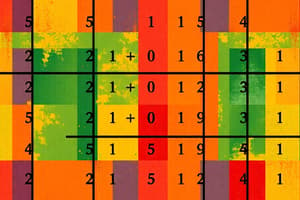Podcast
Questions and Answers
If a pressure greater than the osmotic pressure is applied to a solution separated from a solvent by a semipermeable membrane, what phenomenon occurs?
If a pressure greater than the osmotic pressure is applied to a solution separated from a solvent by a semipermeable membrane, what phenomenon occurs?
- The solution becomes more concentrated as solute particles move across the membrane.
- Osmosis occurs at an accelerated rate, further diluting the solvent.
- The solvent particles move from the solution to the solvent side, known as reverse osmosis. (correct)
- The semipermeable membrane allows both solute and solvent particles to pass freely.
In the context of osmotic pressure, what is the significance of a semipermeable membrane (SPM)?
In the context of osmotic pressure, what is the significance of a semipermeable membrane (SPM)?
- It allows all components of a solution, including solutes and solvents, to pass through freely.
- It actively transports solute particles against the concentration gradient.
- It blocks the movement of both solute and solvent molecules, preventing osmosis.
- It selectively allows solvent molecules to pass through but restricts the passage of solute particles. (correct)
What does the equilibrium hydrostatic pressure developed by a solution column separated from a solvent by a semipermeable membrane define?
What does the equilibrium hydrostatic pressure developed by a solution column separated from a solvent by a semipermeable membrane define?
- Vapor pressure
- Osmotic pressure (correct)
- Surface tension
- Viscosity
What is the correct interpretation of the formula $\pi = \frac{n}{V}RT$ in the context of osmotic pressure?
What is the correct interpretation of the formula $\pi = \frac{n}{V}RT$ in the context of osmotic pressure?
According to the provided information, what is the correct formula for calculating osmotic pressure?
According to the provided information, what is the correct formula for calculating osmotic pressure?
What is the effect of increasing the temperature (T) on the osmotic pressure ($\pi$) of a solution, assuming all other variables remain constant?
What is the effect of increasing the temperature (T) on the osmotic pressure ($\pi$) of a solution, assuming all other variables remain constant?
If $C_1$ and $C_2$ represent the concentrations on either side of a semipermeable membrane, and $C_1 > C_2$, which direction will the particle movement be during osmosis?
If $C_1$ and $C_2$ represent the concentrations on either side of a semipermeable membrane, and $C_1 > C_2$, which direction will the particle movement be during osmosis?
What does the term 'C' represent in the context of the osmotic pressure equation $\pi = CRT$?
What does the term 'C' represent in the context of the osmotic pressure equation $\pi = CRT$?
What is the role of pressure ($P_{ext}$) applied on the solution side in relation to osmotic pressure ($\pi$) when trying to stop the process of osmosis?
What is the role of pressure ($P_{ext}$) applied on the solution side in relation to osmotic pressure ($\pi$) when trying to stop the process of osmosis?
If a solution contains multiple types of solute particles, how is the total concentration 'C' calculated for use in the osmotic pressure equation?
If a solution contains multiple types of solute particles, how is the total concentration 'C' calculated for use in the osmotic pressure equation?
Flashcards
Osmotic Pressure
Osmotic Pressure
The equilibrium hydrostatic pressure of a solution separated from a solvent by a semipermeable membrane.
Osmotic Pressure (Definition)
Osmotic Pressure (Definition)
The external pressure applied to a solution to prevent osmosis.
Reverse Osmosis
Reverse Osmosis
A process where solvent moves from solution to solvent side when pressure exceeds osmotic pressure.
Vant Hoff Formula
Vant Hoff Formula
Signup and view all the flashcards
Ideal Solution Assumption
Ideal Solution Assumption
Signup and view all the flashcards
SPM
SPM
Signup and view all the flashcards
Study Notes
- A matrix is a rectangular array of numbers or expressions arranged in rows and columns.
Example Matrix
$$ A = \begin{bmatrix} a_{11} & a_{12} & \dots & a_{1n} \ a_{21} & a_{22} & \dots & a_{2n} \ \vdots & \vdots & \ddots & \vdots \ a_{m1} & a_{m2} & \dots & a_{mn} \end{bmatrix} $$
- $a_{ij}$ represents the elements or entries within the matrix.
- Rows are horizontal arrays within the matrix.
- Columns are vertical arrays within the matrix.
- An $m \times n$ matrix has $m$ rows and $n$ columns.
- $i$ represents the row index, and $j$ represents the column index.
Types of Matrices
- A square matrix has the same number of rows and columns ($m = n$).
- A column matrix has only one column ($n = 1$).
- A row matrix has only one row ($m = 1$).
- A zero matrix contains only zero elements.
- A diagonal matrix is a square matrix where all non-diagonal elements are zero.
- An identity matrix is a diagonal matrix with all diagonal elements equal to one.
- A symmetric matrix is a square matrix equal to its transpose ($A = A^T$).
- The transpose of a matrix ($A^T$) is formed by interchanging the rows and columns of matrix $A$.
Matrix Operations
- Addition and subtraction are possible if matrices have the same dimensions.
- Scalar multiplication involves multiplying each element of the matrix by the scalar.
- The product of matrices $A$ and $B$ is defined if the number of columns of $A$ equals the number of rows of $B$.
- The inverse of a square matrix $A$ is $A^{-1}$, such that $A \cdot A^{-1} = A^{-1} \cdot A = I$, where $I$ is the identity matrix; only square matrices can have inverses, but not all do.
Determinant of a Matrix
- The determinant of a square matrix is a scalar value encoding properties of the linear transformation described by the matrix.
2x2 Matrix Determinant
- For a 2x2 matrix $A = \begin{bmatrix} a & b \ c & d \end{bmatrix}$, the determinant is calculated as $det(A) = ad - bc$.
3x3 Matrix Determinant
- A 3x3 matrix determinant can be calculated using the rule of Sarrus or cofactor expansion.
Rank of a Matrix
- The rank is the maximum number of linearly independent rows (or columns) in the matrix, measuring the "non-degeneracy" of the system.
- The rank of matrix $A$ is the dimension of the vector space generated by its columns, corresponding to the maximal number of linearly independent columns of $A$. This also equals the dimension of the vector space spanned by its rows.
- Rank is one of the most important characteristics of a matrix.
Studying That Suits You
Use AI to generate personalized quizzes and flashcards to suit your learning preferences.




